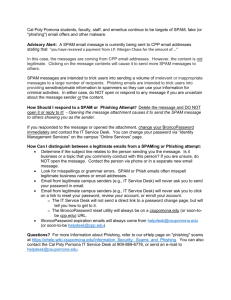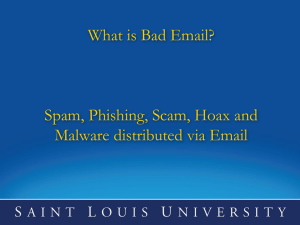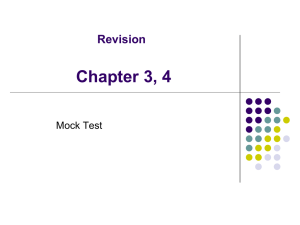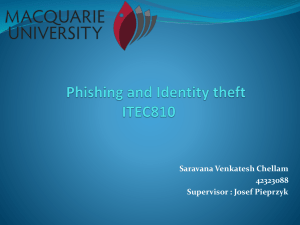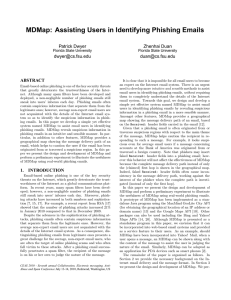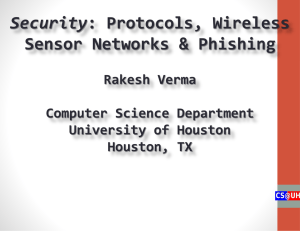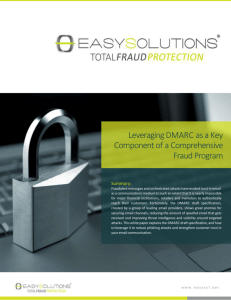Learning to Detect Phishing Emails
advertisement
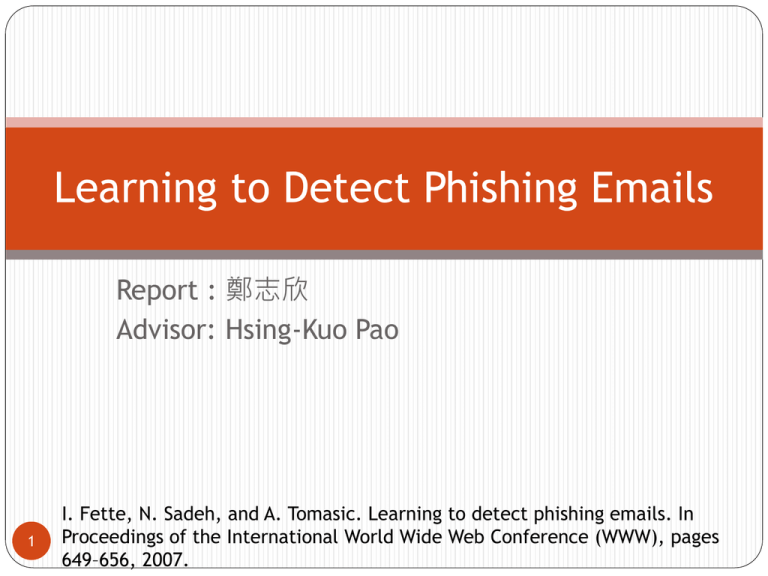
Learning to Detect Phishing Emails Report : 鄭志欣 Advisor: Hsing-Kuo Pao 1 I. Fette, N. Sadeh, and A. Tomasic. Learning to detect phishing emails. In Proceedings of the International World Wide Web Conference (WWW), pages 649–656, 2007. Outline Introduction Method Empirical evaluation Conclusion 2 Introduction Phishing (Spoofed websites) Stealing account information Logon credentials Identity information Phishing Problem – Hard 3 Method PILFER – A Machine Learning based approach to classification. phishing emails / ham (good) emails Feature Set Features as used in email classification 4 Features as used in email classification IP-based URLs: http://192.168.0.1/paypal.cgi?fix_account Phishing attacks are hosted off of compromised PCs. This feature is binary. 5 Age of linked-to domain names Legitimate-sounding domain name Palypal.com paypal-update.com These domains often have a limited life WHOIS query date is within 60 days of the date the email was sent – “fresh” domain. This is a binary feature 6 Nonmatching URLs This is a case of a link that says paypal.com but actually links to badsite.com. Such a link looks like <a href="badsite.com"> paypal.com</a>. This is a binary feature. 7 “Here” links to non-modal domain “Click here to restore your account access” Link with the text “link”, “click”, or “here” that links to a domain other than this “modal domain” This is a binary feature. 8 HTML emails Emails are sent as either plain text, HTML, or a combination of the two - multipart/alternative format. To launch an attack without using HTML is difficult. This is a binary feature. 9 Number of links The number of links present in an email. <a> in HTML tag This is a continuous feature. 10 Number of domains Simply take the domain names previously extracted from all of the links, and simply count the number of distinct domains. Look at the “main” part of a domain https://www.cs.university.edu/ http://www.company.co.jp/ This is a continuous feature. 11 Number of dots Subdomains like http://www.my-bank.update.data.com. Redirection script, such as http://www.google.com/url?q=http://www.badsite.com This feature is simply the maximum number of dots (`.') contained in any of the links present in the email, and is a continuous feature. 12 Contains javascript Attackers can use JavaScript to hide information from the user, and potentially launch sophisticated attacks. An email is flagged with the “contains javascript” feature if the string “javascript” appears in the email, regardless of whether it is actually in a <script> or <a> tag This is a binary feature. 13 Spam-filter output This is a binary feature, using the trained version of SpamAssassin with the default rule weights and threshold. “Ham” or “Spam” This is a Binary feature. 14 Empirical Evaluation Machine-Learning Implementation Testing Spam Assassin Datasets Additional Challenges False Positives vs. False Negatives 15 Machine-Learning Implementation-PILFER First, run a set of scripts to extract all the features listed. Second , we train and test a classifier using 10-fold cross validation. Random Forest (classifier) Random forests create a number of decision trees and each decision tree is made by randomly choosing an attribute to split on at each level, and then pruning the tree. 16 • 17 we use a random forest as a classifier. Testing SpamAssassin SpamAssassin is a widely-deployed freely-available spam filter that is highly accurate in classifying spam emails. We classify the exact same dataset using SpamAssassin version 3.1.0, using the default thresholds and rules. Using “Untrain” SpamAssassin “Training” on 10-fold 18 Datasets Two publicly available datasets. ham corpora from the SpamAssassin project 6950 non-phishing non-spam emails Phishingcorpus approximately 860 email messages 19 Additional Challenges The age of the dataset. Phishing websites are short-lived. Some of our features can therefore not be extracted from older emails, making our tests difficult. EX: Domain linked to 20 Result 21 22 Conclusion it is possible to detect phishing emails with high accuracy by using a specialized filter, using features that are more directly applicable to phishing emails than those employed by general purpose spam filters. 23 Reference I. Fette, N. Sadeh, and A. Tomasic. Learning to detect phishing emails. In Proceedings of the International World Wide Web Conference (WWW), pages 649–656, 2007. www.ics.uci.edu/.../Learning%20to%20Detect%2 0Phishing%20Emails.pptx http://armorize- cht.blogspot.com/2010/01/phishing-mail.html 24 25
